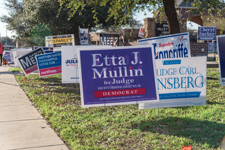
Golfers sustaining injury while out on the links is sometimes “par for the course”. Due to the nature of the sport, California courts consistently apply the “assumption of the risk” doctrine to claims by golf participants against golf course operators for injuries sustained from risks that are inherent in the sport itself. For example:
- “Golf is an active sport to which the assumption of the risk doctrine applies. (Dilger v. Moyles (1997) 54 Cal.App.4th 1452, 1454.)
- A recreation provider “owes no duty to a participant in an active sport to use due care to eliminate risks inherent in the sport.” (American Golf Corp. v. Superior Court (2000) 79 Cal.App.4th 30.)
- “When the risks are inherent, the defendant does not have a ‘duty to protect the plaintiff from those risks…or take steps to reduce those risks.’” (Fazio v. Fairbanks Ranch Country Club (2015) 233 Cal.App.4th 1053, 1058.)
- The inherent risk in golf encompasses more than just the possibility of being struck by an errant golf ball while playing; it also includes the risk of a golfer stepping on or tripping over a tree root in a grassy area near a tee box. (Wellsfry v. Ocean Colony Partners, LLC (2023) 90 Cal.App.5th 1075.)
However, as noted above, the assumption of risk doctrine has been mainly analyzed in the context of injuries sustained by people who are participants (injuries sustained by the golfers themselves). So, what about when a non-participant is injured or sustains some other damage from an errant golf ball? For example, assume that (a) an individual purchases a home adjacent to a golf course that is operated by their homeowners association (HOA), and (b) the homeowner knew (or should have known) of the hazards of errant golf balls when they purchased the home. If that homeowner then sustains injury or property damage from errant golf balls, can the homeowner prevail in legal action against their HOA on the theory that the HOA breached some duty to protect them from such injury or damage?
Nuisance Claims:
California courts have addressed this at least in the context of a nuisance cause of action. In Hellman v. La Cumbre Golf & Country Club (1992) 6 Cal.App.4th 1224, the defendant Country Club was not liable under a nuisance cause of action because, among other things, the plaintiff homeowners knew (or should have known) of the inherent risk of errant golf balls when they first purchased their home bordering the fairway of the 10th hole. Notably, the court in Hellman was not moved by the fact that the plaintiffs’ home was hit with golf balls “every day of the week”, that the plaintiffs’ vehicles sustained damage from errant golf balls, or that the plaintiffs were “afraid to have guests outside during the daytime and [did] not use [their] swimming pool for fear of being hit by golf balls.” Rather, the court upheld the trial court’s decision that the country club was not operating a nuisance because, among other factors, the plaintiffs purchased their property “with knowledge that it was next to a golf course, which put them on at least constructive notice that golf balls would be landing on their property.”
Negligence Claims:
Although the holding in Hellman dealt with nuisance liability, the holding in Neinstein v. Los Angeles Dodgers, Inc. (1986) 185 Cal.App.3d 176 arguably provides a basis to extend the Hellman rationale when evaluating negligence liability. In Neinstein, the court analyzed the assumption of risk doctrine in evaluating the duty of care owed by a baseball stadium to a non-participant (a spectator who was struck by a foul ball). In holding that the stadium was under no duty to protect the spectator, the court in Neinstein noted how the spectator voluntarily elected to enter the area of risk (elected to sit in a section where foul balls were likely to enter) and was “sufficiently warned of the risk by common knowledge of the nature of the sport.”
This assumption of risk analysis for spectators at sporting events arguably extends to those who choose to occupy homes adjacent to golf courses. Although there is no published case law supporting this extension, the Court of Appeal’s unpublished holding in Hernandez v. Ong, No. D038200, 2002 WL 266864 (Cal. Ct. App. 2002) lays out the argument in a compelling way:
“…in baseball the spectator participates in the sport by subjecting himself to certain risks necessarily and usually incident to and inherent in the game. The spectator also accepts the myriad benefits of attendance. Although not a spectator of the golf being played, one who moves into a house that is adjacent to an existing golf course chooses, as does a spectator, to participate in the benefits of the golf courses’ pastoral setting and accepts the inherent dangers of such participation. Persons who move into houses adjacent to existing golf courses are “sufficiently warned of the risk by common knowledge of the nature of the sport.”
| For HOAs with or adjacent to golf courses, exculpatory clauses in their recorded CC&Rs can be useful in exempting the HOA from liability associated with errant golf balls. While such clauses cannot violate a statute or public policy, they are generally enforceable in the HOA setting where they are fair and reasonable. (See Franklin v. Marie Antoinette Condominium Owners Assn. (1993) 19 Cal.App.4th 824). It is recommended that golf course communities consult their HOA legal counsel to ensure their governing documents provide adequate protections for golf-related injury claims. |
 HOA Lawyer Blog
HOA Lawyer Blog




 Update: Compliance is not currently required and the next hearing is scheduled for March 25, 2025
Update: Compliance is not currently required and the next hearing is scheduled for March 25, 2025 *New Case Law
*New Case Law In case you missed it,
In case you missed it,  In the State of California, most HOA’s are non-profit corporations managed by a board of directors composed of volunteer homeowners elected by the membership. Boards derive their authority from the
In the State of California, most HOA’s are non-profit corporations managed by a board of directors composed of volunteer homeowners elected by the membership. Boards derive their authority from the  There will come a time when a homeowner violates an association’s
There will come a time when a homeowner violates an association’s  It is becoming increasingly popular to raise chickens in suburban and even in urban areas. Chickens offer a continuous source of fresh eggs and arguably help with pest control. Conversely, chickens can be loud, messy, attract coyotes, and arguably are best suited for rural, country life. Because many municipalities have legalized raising chickens in residential zones, HOAs are more frequently encountering owners maintaining chickens in their communities, some even allowing their chickens to roam the common area alongside the family dog.
It is becoming increasingly popular to raise chickens in suburban and even in urban areas. Chickens offer a continuous source of fresh eggs and arguably help with pest control. Conversely, chickens can be loud, messy, attract coyotes, and arguably are best suited for rural, country life. Because many municipalities have legalized raising chickens in residential zones, HOAs are more frequently encountering owners maintaining chickens in their communities, some even allowing their chickens to roam the common area alongside the family dog.